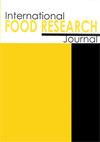Synergistic effect of commercial mangosteen extract (Garcinia mangostana L.) and amoxicillin against methicillin-resistant Staphylococcus aureus (MRSA)
IF 1
4区 农林科学
Q4 FOOD SCIENCE & TECHNOLOGY
引用次数: 0
Abstract
Antibiotic resistance occurs worldwide, and has become a threat to humankind. Previous data have shown that antimicrobial resistance is a global issue demanding immediate resolution because it threatens the environment and society. The present work thus investigated the synergistic effects of commercial Garcinia mangostana L. (GML) extract and amoxicillin on the growth of methicillin-resistant Staphylococcus aureus (MRSA) bacterial cells. A commercial GML extract was screened for phytochemical properties, and the presence of α-mangostin was detected using high-performance liquid chromatography (HPLC). The antibacterial activity of the commercial GML extract with amoxicillin was analysed by minimum inhibitory concentration (MIC) and checkerboard assays. The morphology ultrastructure of bacteria was observed using transmission electron microscopy (TEM), after treatment with commercial GML extract, either single or in combination with amoxicillin. The MICs of amoxicillin and commercial GML extract against MRSA bacteria were 250.00 and 137.50 μg/mL, respectively. The checkerboard assay showed synergistic activity in the combination of commercial GML extract (34.38 µg/mL) and amoxicillin (62.50 µg/mL) at fractional inhibitory concentration (FIC) index of < 0.5. Damage to the structure of bacteria occurred due to the commercial GML extract plus amoxicillin. It was observed that the loss of bacterial cell membranes led to an irregular bacterial structure. These findings provided evidence that the combination of commercial GML extract and amoxicillin could reverse bacterial resistance in order to determine the susceptibility of traditional drugs.山竹提取物与阿莫西林对耐甲氧西林金黄色葡萄球菌的协同作用
抗生素耐药性在世界范围内普遍存在,并已成为对人类的威胁。以前的数据表明,抗菌素耐药性是一个需要立即解决的全球性问题,因为它威胁到环境和社会。本研究探讨了市售山竹藤提取物和阿莫西林对耐甲氧西林金黄色葡萄球菌(MRSA)细菌细胞生长的协同作用。利用高效液相色谱法(HPLC)检测α-山竹苷的存在,并对市售山竹苷提取物进行植物化学性质筛选。采用最小抑菌浓度法(MIC)和棋盘格法(棋盘格法)分析了含阿莫西林的GML市售提取物的抑菌活性。用商业GML提取物单独或与阿莫西林联合处理后,用透射电镜观察细菌的形态超微结构。阿莫西林和GML市售提取物对MRSA细菌的mic分别为250.00和137.50 μg/mL。棋盘实验显示,GML市售提取物(34.38µg/mL)与阿莫西林(62.50µg/mL)联合使用具有协同作用,分数抑制浓度(FIC)指数为<0.5. 由于商业GML提取物加上阿莫西林,细菌的结构发生了损害。观察到细菌细胞膜的丢失导致细菌结构不规则。这些结果为商业GML提取物与阿莫西林联合使用可以逆转细菌耐药性,从而确定传统药物的敏感性提供了证据。
本文章由计算机程序翻译,如有差异,请以英文原文为准。
求助全文
约1分钟内获得全文
求助全文
来源期刊

international food research journal
Agricultural and Biological Sciences-Food Science
CiteScore
1.40
自引率
0.00%
发文量
75
期刊介绍:
The International Food Research Journal (IFRJ) publishes papers in English, six (6) issues a year with the coverage of:
Food Science and Technology
Nutrition and Dietetics
Agriculture, multidisciplinary
Chemistry, multidisciplinary
The scope of the Journal includes:
Food Science, Food Technology and Food Biotechnology
Product Development and Sensory Evaluation
Food Habits, Nutrition, and Health
Food Safety and Quality
Food Chemistry, Food Microbiology, Food Analysis and Testing
Food Engineering
Food Packaging
Food Waste Management
Food Entrepreneur
Food Regulatory
Post-Harvest Food Management
Food Supply Chain Management
Halal Food and Management
 求助内容:
求助内容: 应助结果提醒方式:
应助结果提醒方式:


